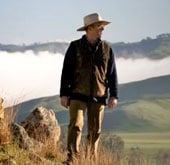 Australia’s farmers play a major role in ensuring that the country’s meat is some of the world’s best. In this short video, you’ll meet one who’s leading charge—sheep and cattle farmer Sam Archer. Not only are Sam and his wife Sabrina making a difference on their 1,500-hectare farm in New South Wales, but they’re also helping Australia to achieve sustainability goals that set an example for the rest of the world to follow. Here’s some of the important information Sam will share with you:
Australia’s farmers play a major role in ensuring that the country’s meat is some of the world’s best. In this short video, you’ll meet one who’s leading charge—sheep and cattle farmer Sam Archer. Not only are Sam and his wife Sabrina making a difference on their 1,500-hectare farm in New South Wales, but they’re also helping Australia to achieve sustainability goals that set an example for the rest of the world to follow. Here’s some of the important information Sam will share with you:
The Australian difference
Australia’s red meat industry and key government and research organizations have made a long-term commitment to food safety, product integrity and sustainability, and traceability. Additionally, Australia is internationally recognized as being free of all major livestock diseases.
A team effort
When it comes to implementing sustainability initiatives, Australia’s got a lot of cooks in the kitchen, from the government to academic organizations and advocacy groups, all involved in research, development and education. Farmers like Sam, however, are often the first to carry the torch. “We think of ourselves as environmental caretakers, because we manage half of Australia’s landmass,” he says.
One thing that sets Australia’s sustainability approach apart is a focus on the entire meat supply chain. There’s more work to be done, but according to Sam, so far, so good—the country’s red meat industry is leading the way in cutting water use, increasing biodiversity, implementing sustainable land management practices, reducing emissions from sheep and cattle and efficiencies in shipping to the USA.
Important goals
According to Sam, the red meat supply chain should conserve and enhance the following: biodiversity, clean air and water, healthy soils and natural ecological practices. It should also aim to “deliver good animal welfare and ensure that the diversity and productivity of the natural environment is maintained and enhanced for the benefit of future generations.”
Walking the walk
On their farm, Sam and Sabrina have been focusing on numerous sustainability improvements, including land use strategies; paddock rotation to “rest” land and maximize animal health; and the promotion of biodiversity through the re-planting of native vegetation along waterways.
They’re also working with key organizations on four important environmental trials, including an environmental services pilot project aiming to establish a market price for environmental credits for carbon, water, salinity and biodiversity.
Not just not food miles
As a whole, the Australian Red Meat Industry is looking at how livestock impacts the environment, using life-cycle assessments to measure the full environmental impact of producing a pound of meat, from the field to the fork. As Sam will tell you, the approach is far more reliable than the concept of food miles—Australia’s livestock industry even plays an important role in removing carbon from the atmosphere.
Looking forward
As technology continues to improve and sustainability initiatives come down the pipeline, Australia is well positioned to continue to be a sustainable meat producing and exporting country. Sam’s prediction: “We’ll be producing the highest quality lamb and beef for your enjoyment, for a long time to come.”
For more on the sustainability of Australian Lamb, click here.

